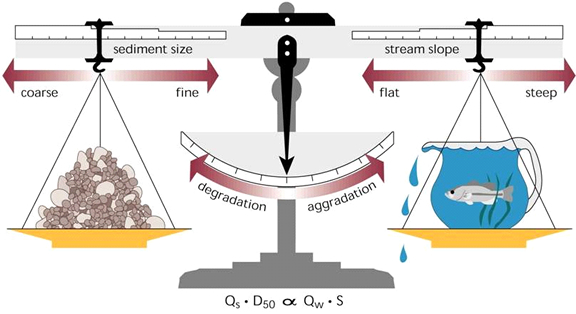Some form of the diagram below is often used as a pedagogical tool, and to represent a theoretical framework, in fluvial geomorphology, hydrology, and river science. It is called a Lane Diagram, and originated in a publication by E.W. Lane in 1955:

The diagram shows that stream degradation (net erosion and incision) and aggradation (net deposition) responds to changes in the relationship between sediment supply (amount of sediment, Qs, and typical sediment size, D50) and sediment transport capacity (a function of discharge or flow, Qw, and slope, S). The diagram is a very helpful metaphor in understanding the sediment supply vs. transport capacity relationship, and its effects on channel aggradation or degradation.
Unfortunately, the Lane relationship has often been misinterpreted as suggesting that streams somehow adjust Qs, Qw, D50, and S (particularly S) to keep the balance precisely in the middle. A more accurate reading is that if the system is precisely balanced (in steady-state), the slightest change in any factor will tip the scales one way or another. Also, if the scale is way overbalanced on the aggradation or degradation side, it may take a lot of change to level it out or tip it back the other way. Note that many rivers are undergoing net aggradation or degradation, while steady-state is relatively rare, except in a very approximate sense.
I like this version of the diagram (I got it here: http://www.fgmorph.com/fg_2_9.php) because it correctly shows the Lane equation as in the original version, with the proportionality symbol, meaning “proportional to.” This is too often incorrectly rendered with an "approxinately equal" sign, or a ~, which can be interpreted the same. Basically, the Lane relationship means that a change in sediment size, sediment quantity, discharge, or slope will result in a change in at least one of the other variables, and that aggradation and degradation depend on the proportionality of sediment supply and transport capacity.
In retrospect, I wonder if use of the scale/balance visual metaphor has contributed to the misunderstanding that the relationship implies that balance between sediment supply and transport capacity will be maintained.
